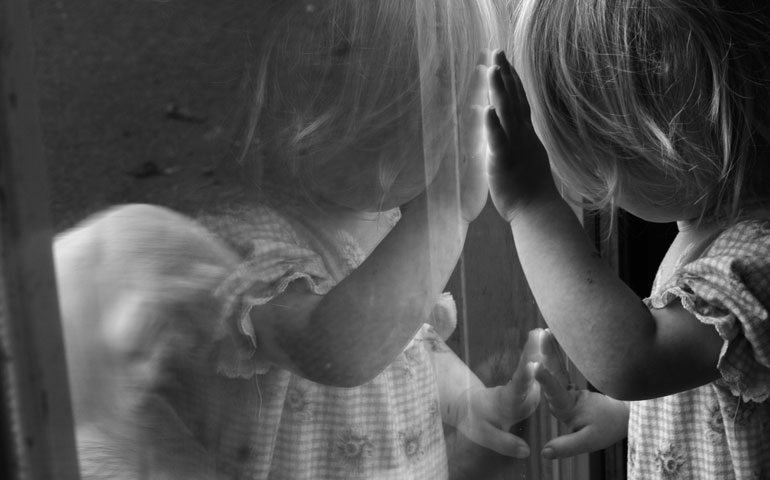
Kristi Link Fernholz’s 2008 photograph “Sister” shows her daughter Anika, whose twin, Nora, died at the age of 3 days old. (Kristi Link Fernholz, klfstudio.com)
 SHE WHO IMAGINES: FEMINIST THEOLOGICAL AESTHETICS
SHE WHO IMAGINES: FEMINIST THEOLOGICAL AESTHETICS
Edited by Laurie Cassidy and Maureen H. O’Connell
Published by Liturgical Press, $29.95
When it comes to theological aesthetics, consideration of women’s perspectives and understandings has, more often than not, been nonexistent or very limited. Historically, masculine interpretations of beauty and justice have informed the intersection between aesthetics and ethics, say Laurie Cassidy and Maureen H. O’Connell, editors of the new collection She Who Imagines: Feminist Theological Aesthetics.
According to Cassidy and O’Connell, women are typically portrayed as objects rather than creators and/or subjects of beauty.
In She Who Imagines, 12 authors, all women, use feminist methodology to present their own experiences and research, with the hope of widening the conversation. They offer new and invigorating insights into the conversation of theological aesthetics, an interdisciplinary study that explores theology in light of the arts and beauty.
In her forward, St. Joseph Sr. Elizabeth Johnson states that the essays “link women’s definitions of beauty with experiences of suffering and hence with the yearning for justice.” The conversation moves from being strictly a discussion of simplified beauty to an appreciation and heart-wrenching understanding of struggle and the complexity of beauty intertwined with justice.
The essays are divided into three sections. The first focuses on women as subjects of beauty, emphasizing the “She” in She Who Imagines. The second section, titled “She Who Is Imagined,” emphasizes “the dynamics of race, class, and gender oppression.” The third, “She Who Imagines,” discusses women as agents of beauty.
Many people are familiar with the Pietà, the striking image of Jesus being held by his mother after his death on the cross. In the first section of the book, Jayme M. Hennessy’s essay, “Kollwitz: The Beauty and Brutality of the Pietà,” discusses a very different representation of this image. In 1938, German artist Käthe Kollwitz created a small bronze Pietà that broke away from masculine imagery of beautifying violence. Instead, Kollwitz crafted what she believed to be a true representation of the gravity of human brutality and horror of death, both of which she had witnessed when her youngest son died in World War I.
Kollwitz’s sculpture shows a dark, brooding mother who does not offer up her son’s body. As a grieving mother herself, Kollwitz wanted to create a realistic representation of what it is like to lose a son in a violent way. Although she did not intend for her piece to be a religious symbol, her Pietà reminds its viewers of the need for religious images to engage in the reality of suffering and loss in order to come to a fuller understanding of the Incarnation and the complexity of being human.
Also found in the first section is Colleen Mary Carpenter’s essay, “Contemplating the Landscapes of Motherhood: The Discovery of Beauty in a Place We Thought We Knew.” Here, Carpenter addresses simultaneously the limitations and complexities Kristi Link Fernholz offers in her photos of motherhood and the Minnesota landscape.
Instead of being an object, Fernholz is a creator of beauty in her photographs of everyday life. Her photos capture the beauty and depth of motherhood as seen in her eyes. Carpenter makes note of just this, stating that these images present the landscape of one mother. Yet, in Fernholz’s photos, the viewer witnesses “something real and … important about the wider landscapes of motherhood.”
Fernholz turns the ordinary into the beautiful, giving depth to her daily experiences of being a mother. Her photographs provide an important lesson on perspective and the significance of deepening our imaginations.
One of the editors, O’Connell, contributed an essay in the final section of the book titled “A Harsh and Dreadful Beauty: The Aesthetic Dimension of Dorothy Day’s Ethics.” Here the reader witnesses Day’s adamant devotion to the connections between the beautiful and the just throughout the Catholic Worker movement. Her intentional relationships with poor persons and her determination to find beauty contributed to her pursuit of justice.
Ade Bethune, creator of the woodcut image on the masthead of The Catholic Worker newspaper, recalls how Day believed in providing images of “good things” (vines and grapes, mother and children, etc.) to counter the “troubleness and bitterness of the world.” In acknowledging the ugliness of poverty, Day believed people could create the kind of humility needed in reversing the systems that sustain such brokenness. The hospitality Day and other members of the Catholic Worker movement offered was always tagged with some aspect of beauty, no matter how simple.
Through novels, nature, art and music, Day found solace in human vulnerability and ugliness, a sense of beauty rose from the forsaken. As a mother and grandmother as well as a writer, Day became a true creator and subject of beauty.
Readers can expect to find unique experiences and understandings about beauty and the struggle for justice throughout the book. Some may wish for essays by women outside of the United States, but the editors make note of the limitations of this book. She Who Imagines is the beginning of this conversation on women as creators and agents of beauty.
[Porsia Tunzi was an NCR Bertelsen intern from August 2012 to May 2013.]




